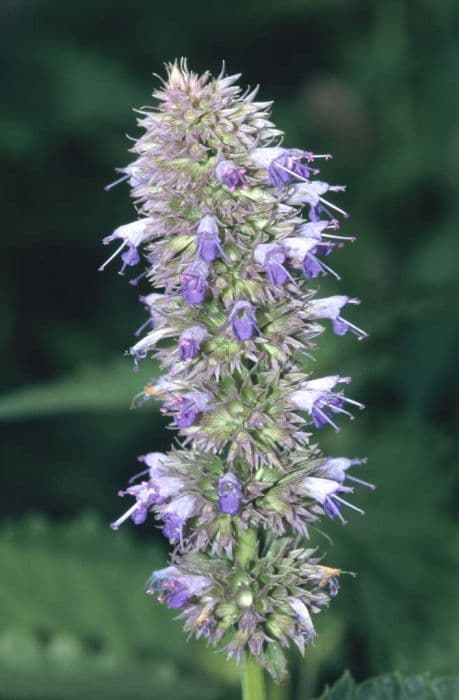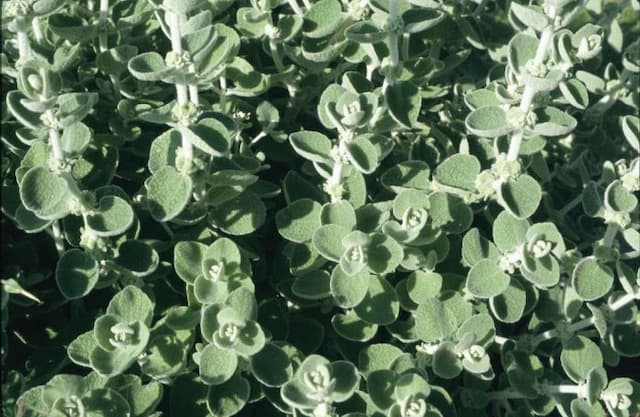Tall Skullcap Scutellaria altissima

ABOUT
Scutellaria altissima, commonly known as the Tall Skullcap, is an herbaceous perennial plant known for its striking appearance. It typically has a bushy, clumping habit and is characterized by its square stems, which is a common trait of the mint family to which it belongs. The leaves of the Tall Skullcap are usually lanceolate to ovate in shape, with edges that can be smooth or slightly serrated. They are often arranged oppositely on the stem, creating a symmetrical look. One of the most prominent features of this plant is its flowers. The Tall Skullcap produces small, tubular flowers that come in an array of colors, commonly shades of blue to violet, though they can also be pink or white. These flowers have a hooded upper lip, which is why the plant is called "Skullcap," resembling a medieval helmet known as a "scutellum." The lower lip of the flower often has two lobes and is adorned with subtle veining or spots, which serves as a nectar guide for pollinators. The flowers are usually grouped in racemes or inflorescences that rise above the foliage, making them quite noticeable when the plant is in bloom. The fruit of the Tall Skullcap is a small nutlet, which is typical for plants in the mint family. Overall, the plant's appearance is highly appreciated in garden settings for its ornamental flowers and its ability to attract bees, butterflies, and other pollinators.
About this plant
 Names
NamesFamily
Lamiaceae
Synonyms
Tall Skullcap, High Skullcap
Common names
Scutellaria altissima L.
 Toxicity
ToxicityTo humans
The plant Scutellaria altissima, commonly known as the tall skullcap, is not widely recognized for its toxicity to humans. However, like other members of the Scutellaria genus, it may contain compounds such as scutellarin and baicalin, which have various effects on the human body. There is limited specific information on the toxicity of tall skullcap to humans, but taking cues from the effects of related species, overconsumption might result in potential side effects including liver damage or interactions with other medications. If any part of the plant were ingested in large quantities, possible symptoms could include confusion, drowsiness, or gastrointestinal upset. Nevertheless, to fully understand the consequences of ingesting tall skullcap, scientific studies dedicated to this specific species are required.
To pets
The plant Scutellaria altissima, commonly known as the tall skullcap, has not been specifically documented for its toxicity in pets. In general, the Scutellaria genus may contain compounds that could potentially cause mild to moderate gastrointestinal upset if ingested by pets, such as dogs or cats. Symptoms of poisoning might include vomiting, diarrhea, or lethargy. It's important to note, though, that pet sensitivity to plants can vary widely, and if you suspect your pet has ingested tall skullcap or is showing signs of illness, it would be prudent to seek advice from a veterinarian.
 Characteristics
CharacteristicsLife cycle
Perennials
Foliage type
Deciduous
Color of leaves
Green
Flower color
Blue
Height
1-2 feet (30-60 cm)
Spread
1-2 feet (30-60 cm)
Plant type
Herb
Hardiness zones
4
Native area
Europe
Benefits
 General Benefits
General Benefits- Erosion control - Scutellaria altissima has deep roots that help stabilize soil and prevent erosion.
- Habitat for wildlife - It provides shelter and food for a variety of insects, which in turn supports bird populations.
- Drought resistance - Adapted to survive in dry conditions, requiring less water and maintenance.
- Aesthetic appeal - The plant adds visual interest to gardens with its height and flowers.
- Pollinator-friendly - Attracts bees, butterflies, and other pollinators, supporting biodiversity.
 Medical Properties
Medical Properties- Antioxidant properties: Scutellaria altissima may have compounds with antioxidant effects that help to neutralize free radicals in the body.
- Neuroprotective effects: Some studies suggest potential neuroprotective properties that could be beneficial for neuronal health.
- Anti-inflammatory properties: The plant may contain substances that help reduce inflammation in the body, relevant to various inflammatory conditions.
- Anxiolytic effects: There is some evidence to suggest that Scutellaria species may help alleviate anxiety through interactions with neurotransmitter systems.
- Antimicrobial activity: Compounds in Scutellaria altissima might exhibit activity against certain bacteria and fungi.
- Anti-tumor potential: Preliminary research indicates the possibility that some compounds in the plant could have anti-tumor effects.
- Hepatoprotective properties: There might be hepatoprotective compounds in Scutellaria altissima that protect liver cells from damage.
 Air-purifying Qualities
Air-purifying QualitiesThis plant is not specifically known for air purifying qualities.
 Other Uses
Other Uses- Scutellaria altissima, commonly known as Tall Skullcap, can be used in natural fabric dyeing processes, providing a range of colors from yellows to greens depending on the mordants used.
- The Tall Skullcap’s roots contain tannins which may be used for tanning leather, a practice once common with various plant materials.
- With its attractive flowers, Tall Skullcap can be planted in gardens as an ornamental plant to enhance visual appeal and support local biodiversity.
- The plant can be used in companion planting strategies to attract pollinators like bees and butterflies, which are essential for the pollination of many crops.
- Tall Skullcap seeds can be a food source for birds, thus contributing to the sustenance of local avian populations when grown in the wild or in a garden setting.
- The dense foliage of the Tall Skullcap may provide a habitat for beneficial insects, offering a mini sanctuary and promoting a balanced ecosystem.
- In permaculture designs, Tall Skullcap could be incorporated as a ground cover to suppress weeds and maintain soil moisture levels.
- As part of a wildlife-friendly garden, the plant can also offer shelter for small animals and insects.
- Due to its height, the Tall Skullcap might be used in creating natural garden borders or living fences that can divide sections of a garden with a soft, green partition.
- Finally, in educational botanical gardens, Tall Skullcap can serve as an example of native flora and help in the education of plant biology and conservation efforts.
Interesting Facts
 Feng Shui
Feng ShuiThe Scutellaria altissima is not used in Feng Shui practice.
 Zodiac Sign Compitability
Zodiac Sign CompitabilityThe Scutellaria altissima is not used in astrology practice.
 Plant Symbolism
Plant Symbolism- Protection: Scutellaria altissima, commonly known as tall skullcap, has historically been associated with safety and defense, potentially due to its hardy nature and the protective calyx that shields its seeds.
- Healing: The skullcap family of herbs, to which tall skullcap belongs, has been used in various traditional medicines, which gives it an association with health and restoration.
- Peace: Skullcap plants have been thought to promote calmness and tranquility, possibly stemming from their use in herbal remedies for anxiety and nervous tension.
 Water
WaterThe Tall Skullcap should be watered regularly during its growing season, typically aiming to keep the soil consistently moist but not waterlogged. Water the plant when the top inch of soil feels dry to the touch, which might be once every week or so, depending on climate conditions and the plant's environment. Use room temperature water, and gently pour it around the base of the plant, avoiding wetting the foliage, with about one to two gallons per week for an outdoor garden plant of average size. During winter or dormant periods, reduce watering frequency allowing the soil to dry out slightly between waterings.
 Light
LightTall Skullcap thrives in a variety of light conditions, but it does best in full sun to partial shade. The ideal location would be a spot where the plant can receive at least 4 to 6 hours of sunlight per day. However, if you're in a particularly hot climate, providing some afternoon shade will help protect the plant from excessive heat stress.
 Temperature
TemperatureThe Tall Skullcap prefers temperate environments with temperatures ranging between 50–70 degrees Fahrenheit for optimal growth. It can tolerate minimum temperatures down to around 30 degrees Fahrenheit but may suffer if exposed to frost. During the active growing season, maintaining an environment that is on the warmer end of this spectrum will encourage healthy development.
 Pruning
PruningPruning the Tall Skullcap is beneficial for maintaining its shape and encouraging bushier growth. Prune back the plant by up to one-third in late winter or early spring before new growth begins. This timing allows the plant to heal and to put out fresh growth, which results in a more robust plant. Deadheading, or the removal of spent flowers, can be done as needed during the flowering season to encourage further blooming.
 Cleaning
CleaningAs needed
 Soil
SoilTall Skullcap prefers well-drained soil with a neutral to slightly alkaline pH between 7.0 and 7.5. A soil mix consisting of loam, sand, and a small amount of compost or aged manure will provide the nutrients and texture needed for optimal growth.
 Repotting
RepottingTall Skullcap does not require frequent repotting and can be repotted every two to three years to refresh the soil and accommodate growth.
 Humidity & Misting
Humidity & MistingTall Skullcap thrives in moderate humidity levels but is adaptable and does not require specific humidity conditions to grow successfully.
 Suitable locations
Suitable locationsIndoor
Place in bright, indirect light with good air circulation.
Outdoor
Plant in well-drained soil; full sun to partial shade.
Hardiness zone
4-9 USDA
 Life cycle
Life cycleScutellaria altissima, commonly known as the Tall Skullcap, begins its life as a seed that germinates in late winter to early spring when soil temperatures are suitable. Once germinated, the seedling emerges, developing a root system and a rosette of leaves at ground level during its first year of growth. The Tall Skullcap then undergoes a period of vegetative growth, in which the plant increases in size and produces more foliage. In its second year, it produces flowering stems that can reach up to 80 cm tall, with blooms that are typically blue to violet and occur in the summer months. Following pollination, often by bees, the plant sets seed in small, helmet-shaped capsules, which are dispersed by various means including wind and animal movement. The plant is a perennial, so after setting seed, it may die back to the ground, with the roots surviving the winter to regenerate the following spring.
 Propogation
PropogationPropogation time
Spring to early summer
The most popular method for propagating the Scutellaria altissima, commonly known as Tall Skullcap, is through seed sowing. Seeds can be sown directly outdoors in the fall where they will naturally stratify over the winter, improving germination rates in spring. For spring planting, seeds should be cold-stratified for several weeks before sowing, which can be done by placing them in a moistened medium inside a refrigerator (around 40 degrees Fahrenheit or 4 degrees Celsius) for approximately four to six weeks. After cold stratification, the seeds can be sown in well-draining soil, lightly covered with soil (about 1/4 inch or about 6 millimeters), and kept moist until germination, which typically occurs within two to three weeks. Tall Skullcap prefers partial to full sunlight and well-drained soil, and these conditions should be ensured for optimal growth and development after germination.









